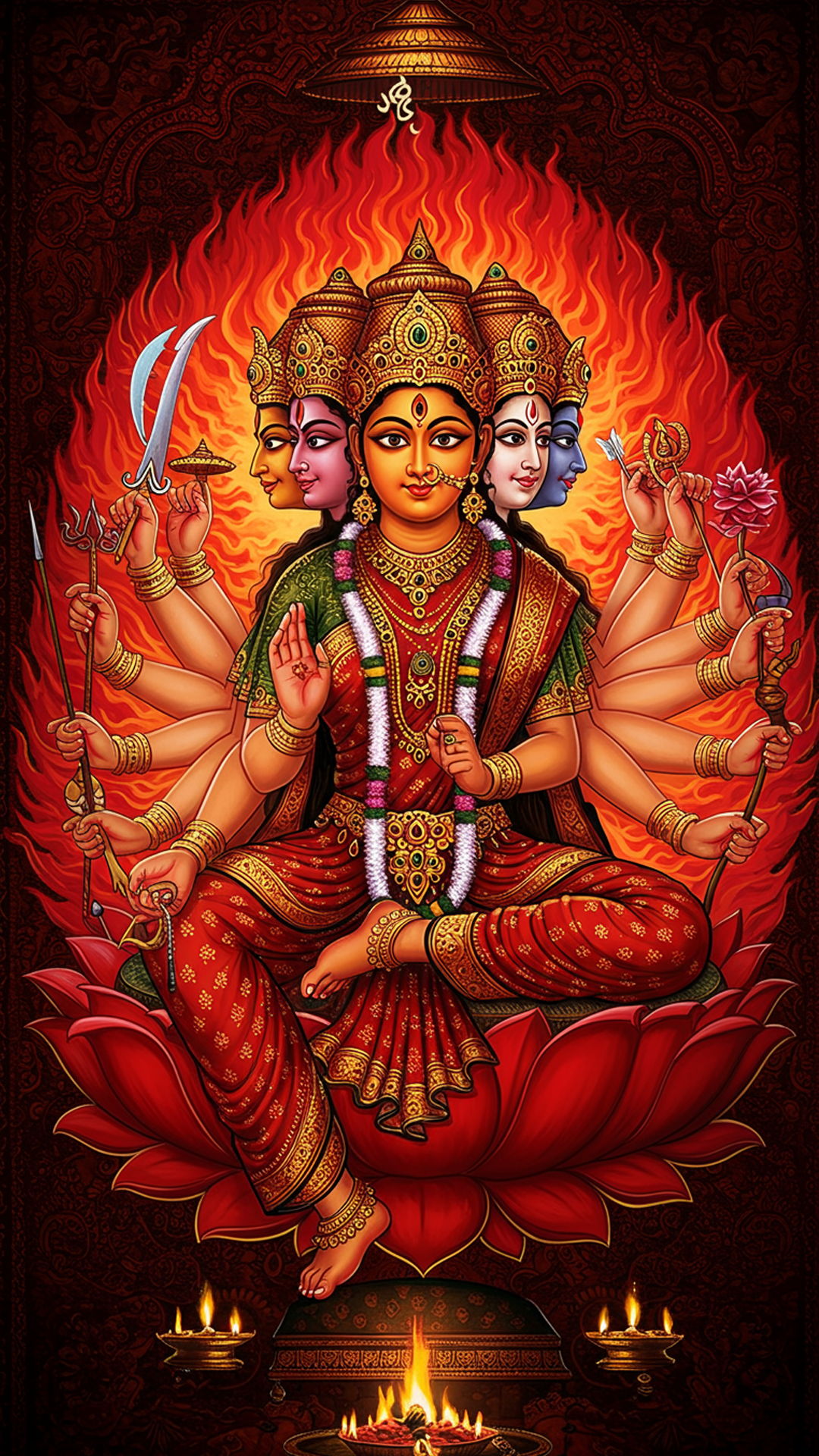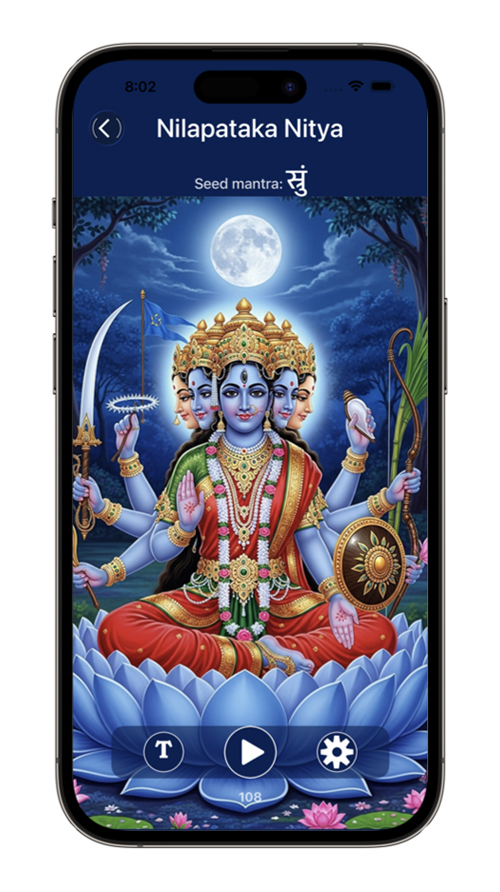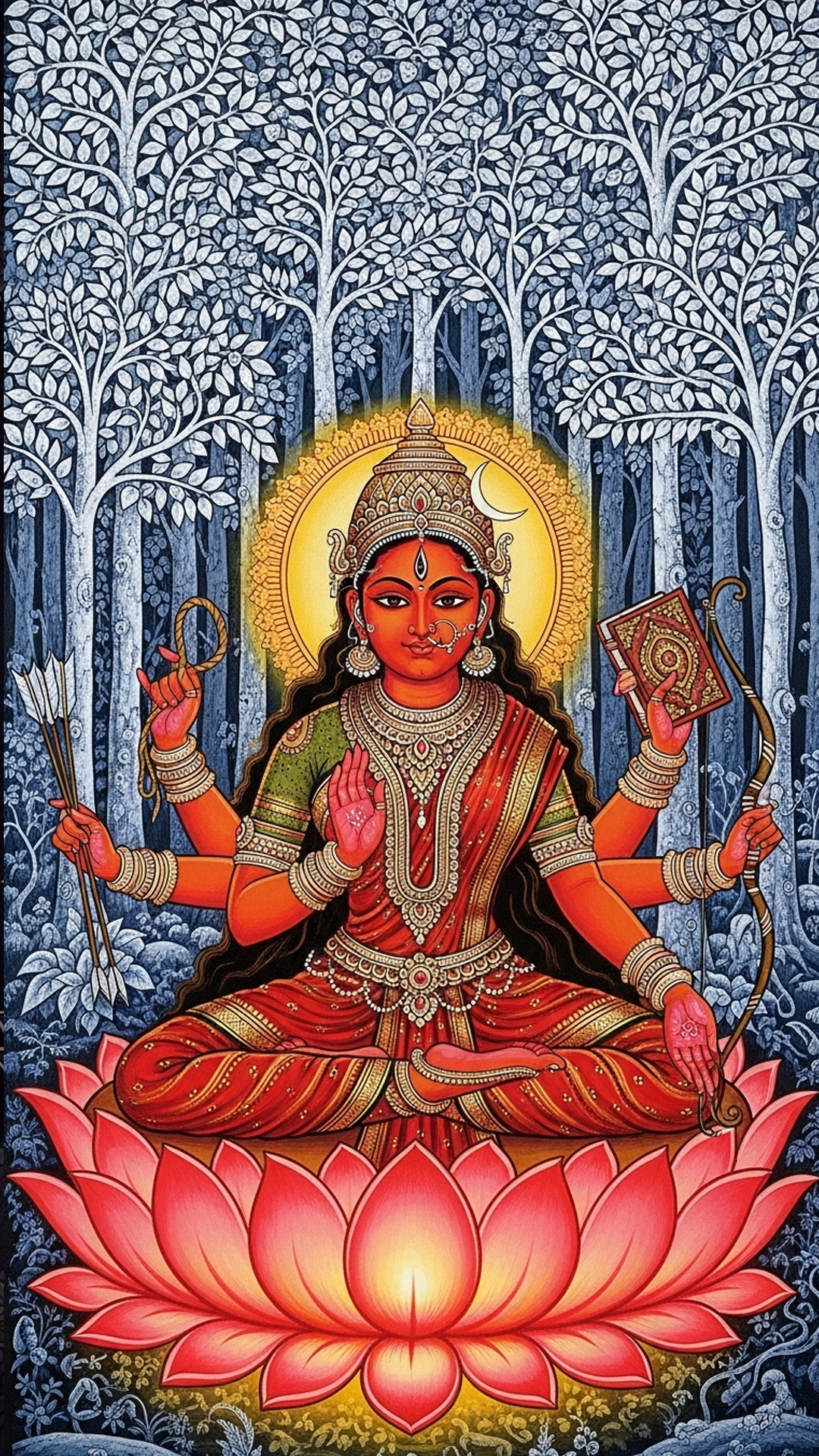
Kāmeśvarī: The Goddess of Manifestation and Harmonious Desire
Kāmeśvarī (Mistress of Desire)
is the paramount aspect of the Divine Feminine in the Śrī Kula tradition,
representing the first of the Nityās (eternal goddesses of the lunar phases).
She embodies the ultimate power of Icchā Śakti (the power of Will or Desire)
that initiates all cosmic creation and fulfillment.
Meditation on Kāmeśvarī offers a pathway to:
* Fulfillment of
Intentions: She is the source of the power that brings about the results of
one’s deepest will and purpose, fostering manifestation and creative energy.
* Harmonization and Unity:
She grants the power to integrate and align all elements—thoughts, beings, and
circumstances—into a state of harmony and balance, bringing discord to a halt.
* Dynamic Transformation:
She is the force that stirs and activates the universe, initiating necessary
movement, growth, and dynamic change in one's life.
Divine Form for Meditation
Meditate upon the Goddess Kāmeśvarī, whose form shines with the brightness of a million rising suns.
* Appearance: She is three-eyed and wears radiant red garments and red ornaments, including a crown of rubies.
Her forehead is graced by the crescent moon, and her face holds a gentle,
compassionate smile.
* Attributes: In her six hands, she holds the implements of pure attraction and creativity: the noose
and goad (representing control and direction), a sugarcane bow and five
flower-tipped arrows (representing the delightful power of the senses), and a jewel-filled
cup of liquor (symbolizing intoxicating bliss). She offers the gesture of
bestowing boons (granting wishes).
* Seat: She is perpetually
seated upon the Śrī Cakra Yantra, symbolizing her position as the mistress of
the entire cosmic structure, directing all energies from the innermost point of
creation to the outer boundaries of form.
Variant Meditation Forms
While her primary form is fiery red and six-handed, Kāmeśvarī is also meditated upon in other forms
depending on the focus:
* The Yoginī Form: In this aspect, she is described as white, adorned with white garlands and shining
pearls. She holds a book and a rosary, emphasizing her role as the source of
knowledge (Jñāna) and spiritual practice (Yoga).
* The Scholar Form: Another description depicts her holding a crystal rosary, the sugarcane bow and arrows,
and a sacred book, highlighting her nature as the Mother of All Beings,
blending desire with wisdom.
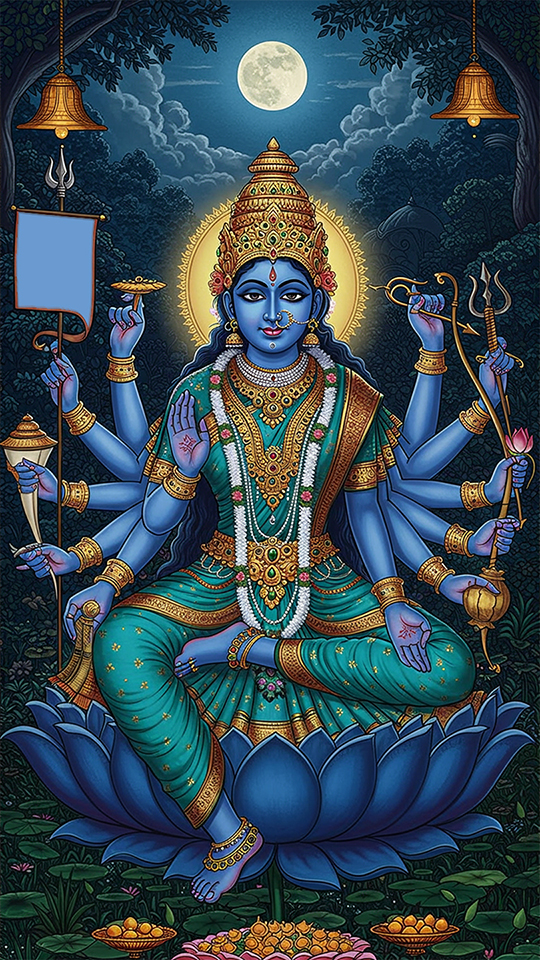
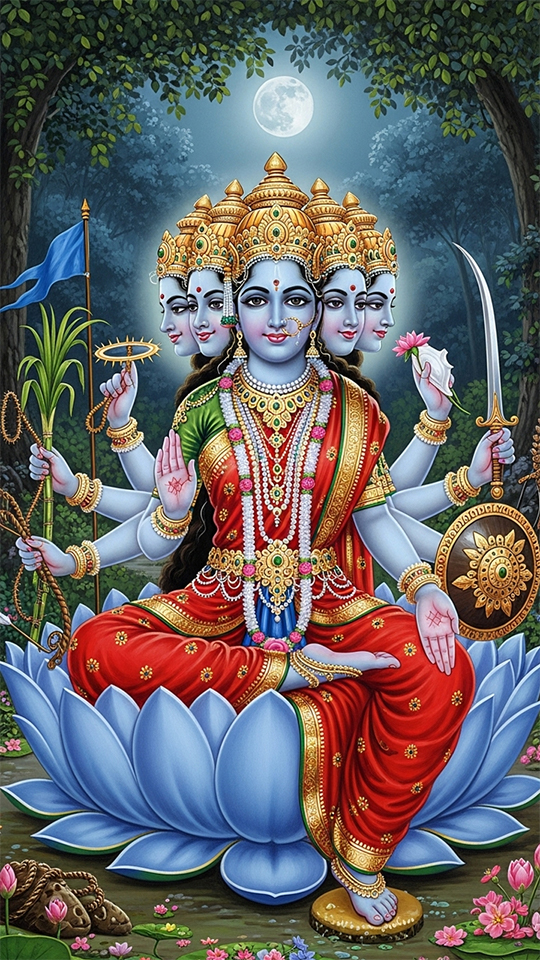
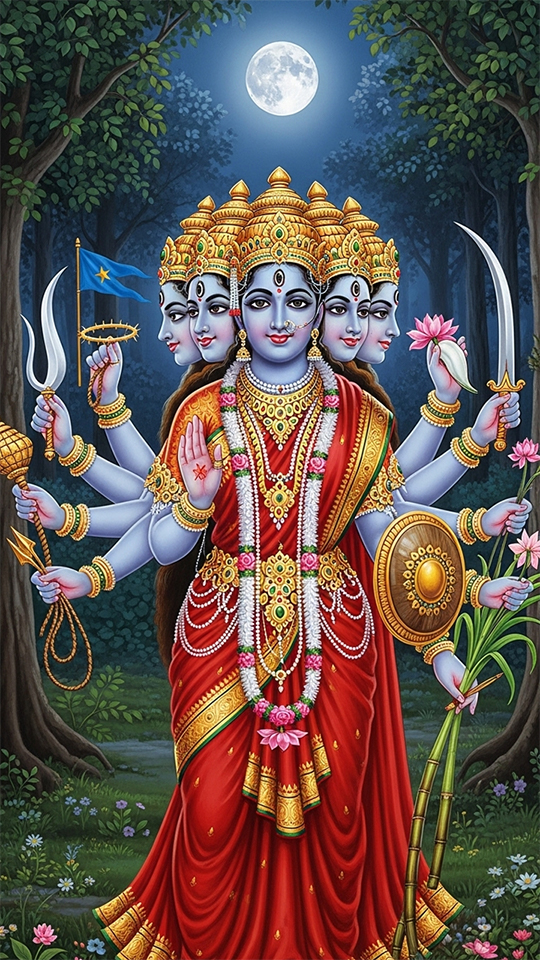
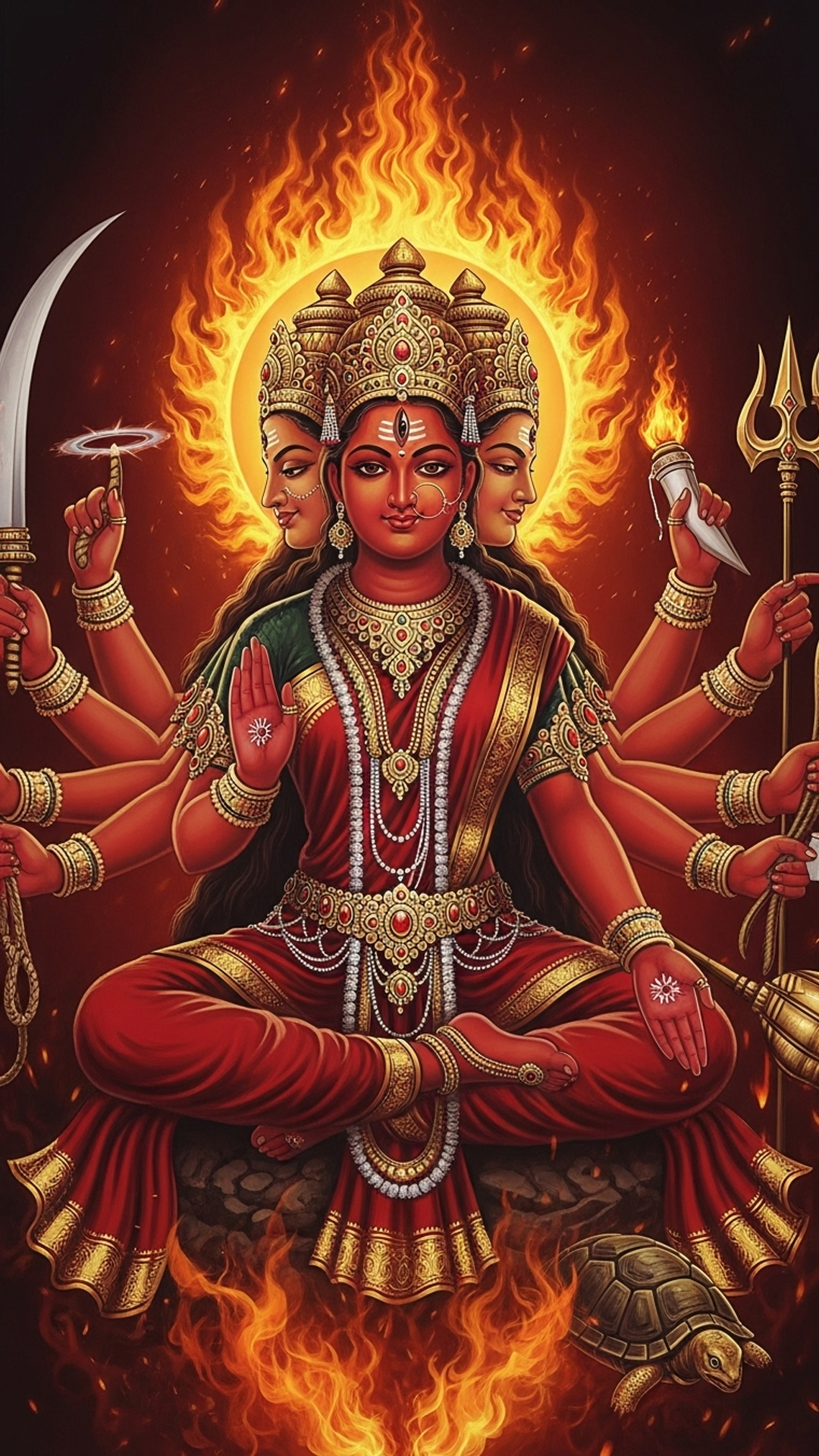
The Fifteen Nityās - synthesis
1. Kāmeśvarī
· Red complexion, body smeared with red garments and ornaments.
· Holds: noose, goad, bow, arrows, book, rosary.
· Gestures: boon-granting and fear-dispelling.
· Radiance of rising sun, seated in Kadamba forest.
· Capable of attracting the three worlds.
· Grants subordination, good fortune, and eloquence.
2. Bhagamālinī
· Red, crescent moon on head, three eyes.
· Perspiring face, intoxicated eyes, beauty dazzling like a jewel.
· Holds: noose, goad, skull.
· Gestures: boon-granting and fear-dispelling.
· Seated in lotus posture.
3. Nityaklinnā
· Radiant like a crore moons, dripping nectar.
· Blue throat, three eyes, adorned with ornaments.
· Radiance of sapphire, vehicle: peacock.
· Holds: noose, goad, skull, dagger.
· Gestures: boon-granting and fear-dispelling.
4. Bheruṇḍā
· Destroyer of poison.
· Radiance of shining sapphire, adorned with various ornaments.
· Holds: noose, goad, skull, dagger.
· Gestures: boon-granting and fear-dispelling.
5. Vahnivāsinī
· Radiance of heated gold, adorned with jewelled crown and ornaments.
· Holds: noose,a solar simbol, goad,, śakti.
· Gestures: boon-granting and fear-dispelling.
6. Mahāvajreśvarī
· Like a hibiscus, shining with red garments and ruby ornaments.
· Adorned with ornaments, in a state of intoxication from drinking nectar from a skull.
· Holds: noose, goad.
· Gesture: dispelling fear.
7. Śivadūtī
· Colour of durva grass, three eyes, seated on a great throne.
· Holds: conch, enemy, bow, arrows, hook, noose.
· Gestures: boon-granting and fear-dispelling.
· Dark body, lotus-like red hands and feet.
· Adorned with anklets of bulls and snakes, ornaments of leaves, girdle of snakes.
· Fearsome yet auspicious.
8. Tvaritā
· Radiance of peacock feathers, adorned with bracelets and jewelled armlets.
· Earrings of bird and snake, intoxicated red eyes.
· Dark curly braid with flowers, holding a skull.
· Of the Kirāta tribe, proudly seated on a shining throne.
· Gestures: boon-granting and fear-dispelling.
9. Kulasundarī
· In Kadamba forest, seated in jewelled pavilion under pearl umbrella.
· Throne adorned with gems.
· Crown, earrings, necklaces, bangles, pearls, white silk garments.
· Lotus-like red feet with diamond anklets.
· Body anointed with auspicious paste and camphor.
· Holds: book, rosary.
· Gestures: boon-granting and fear-dispelling.
· Bestows Sarasvatī’s supreme knowledge.
10. Nityā (Maheśānī)
· Seated on white garment, charming and cheerful.
· Radiance of moon and jasmine.
· Moonlike face, adorned with jewels and pearls.
· Nectar-dripping ornaments.
11. Nīlapatākā
· Radiant like the moon, adorned with various jewels.
· Seated with blue banner.
· Gestures: boon-granting and fear-dispelling.
12. Vijayā
· Adorned with golden ornaments and garments.
· Radiant like lightning.
· Proudly seated on a great throne.
13. Sarvamaṅgalā
· Auspicious goddess, bestower of all blessings.
14. Jvālāmālinī
· Terrifying, shining with golden garments.
· Holds: conch, disc, sword, shield, trident, drum, drinking cup.
· Gesture: boon-granting.
· Destroyer of enemies.
15. Citrā
· White body, giver of knowledge, eternal.
· Colourful forehead mark, saffron radiance.
· Four arms, three eyes.
· Holds: noose, goad, bow, arrows.
· Gestures: boon-granting and fear-dispelling.
· Brings prosperity.
The fifteen Nityās, apart from Lalitā, are revered as the presiding goddesses of the lunar days. They remain eternally connected with the waxing and waning phases of the moon, each embodying a specific lunar energy. Beginning with Kāmeśvarī, the fifteen Nityās represent the fifteen tithis (lunar days), symbolizing the growing and diminishing aspects of the moon. For this reason, every Nityā is adorned with a lunar digit. Lalitā Tripurasundarī, however, transcends these cycles. She embodies the undiminishing, eternal portion of the moon — the source from which the fifteen Nityās manifest. Unlike them, she does not bear a crescent moon. In many texts, Lalitā is therefore honored as the sixteenth Nityā, uniting and completing the full cycle of lunar divinity.
16. Tripurasundarī
· Radiant like the morning sun, red garments, red ornaments.
· Crown of rubies, pearl necklaces, jewelled bangles.
· Four arms, three eyes.
· Holds: noose, goad, bow, arrows.
· Auspicious giver of prosperity and bliss.
